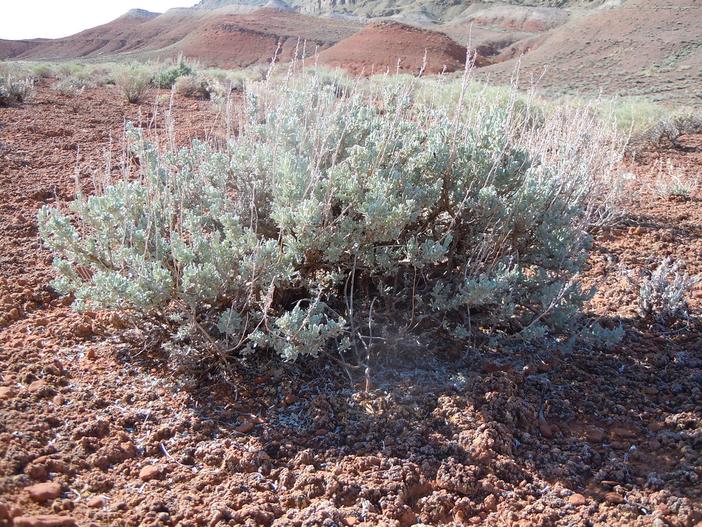Wyoming Big Sagebrush
(Artemisia tridentata subsp. wyomingensis)
Wyoming Big Sagebrush (Artemisia tridentata subsp. wyomingensis)
/
/

Matt Lavin
CC BY-SA 2.0
Image By:
Matt Lavin
Recorded By:
Copyright:
CC BY-SA 2.0
Copyright Notice:
Photo by: Matt Lavin | License Type: CC BY-SA 2.0 | License URL: https://creativecommons.org/licenses/by-sa/2.0/ | Uploader: Matt Lavin | Publisher: Flickr
























Estimated Native Range
Summary
Artemisia tridentata subsp. wyomingensis, commonly known as Wyoming big sagebrush, is a deciduous shrub native to the sagebrush steppe ecosystem of the western United States, particularly in states like Wyoming, Montana, and parts of the Great Basin. It typically grows to a height of 2 to 4 feet (0.6 to 1.2 meters) with a similar spread. The shrub has a rounded form with silvery-gray foliage and a distinctive three-lobed leaf pattern. Wyoming big sagebrush blooms with inconspicuous yellow flowers in the late summer to early fall. The plant is not particularly showy, but its foliage provides a unique texture and color contrast in the landscape.
Wyoming big sagebrush is valued for its hardiness in arid conditions and its role in habitat restoration and erosion control on disturbed lands. It is drought-tolerant, requiring minimal supplemental water once established, and prefers well-drained soils with full sun exposure. This shrub is also used in xeriscaping and as a windbreak in suitable regions. While it is not commonly used for ornamental purposes, it can be a practical choice for naturalistic plantings. Gardeners should be aware that it can become quite large and may spread if not managed. Additionally, it can be susceptible to root rot in poorly drained soils and may attract sagebrush-specific pests such as the sagebrush defoliator moth.CC BY-SA 4.0
Wyoming big sagebrush is valued for its hardiness in arid conditions and its role in habitat restoration and erosion control on disturbed lands. It is drought-tolerant, requiring minimal supplemental water once established, and prefers well-drained soils with full sun exposure. This shrub is also used in xeriscaping and as a windbreak in suitable regions. While it is not commonly used for ornamental purposes, it can be a practical choice for naturalistic plantings. Gardeners should be aware that it can become quite large and may spread if not managed. Additionally, it can be susceptible to root rot in poorly drained soils and may attract sagebrush-specific pests such as the sagebrush defoliator moth.CC BY-SA 4.0
Plant Description
- Plant Type: Shrub
- Height: 1.5-9 feet
- Width: 1.5-9 feet
- Growth Rate: Moderate
- Flower Color: Yellow
- Flowering Season: Summer, Fall
- Leaf Retention: Deciduous
Growth Requirements
- Sun: Full Sun
- Water: Low
- Drainage: Medium, Fast
Common Uses
Drought Tolerant, Erosion Control, Low Maintenance
Natural Habitat
Native to the sagebrush steppe ecosystem of the western United States, particularly in Wyoming, Montana, and parts of the Great Basin
Other Names
Common Names: Wyoming Sagebrush, Big Sagebrush, Basin Sagebrush
Scientific Names: , Artemisia tridentata subsp. wyomingensis, Artemisia tridentata var. wyomingensis, Seriphidium tridentatum subsp. wyomingense, Seriphidium tridentatum var. wyomingense,
GBIF Accepted Name: